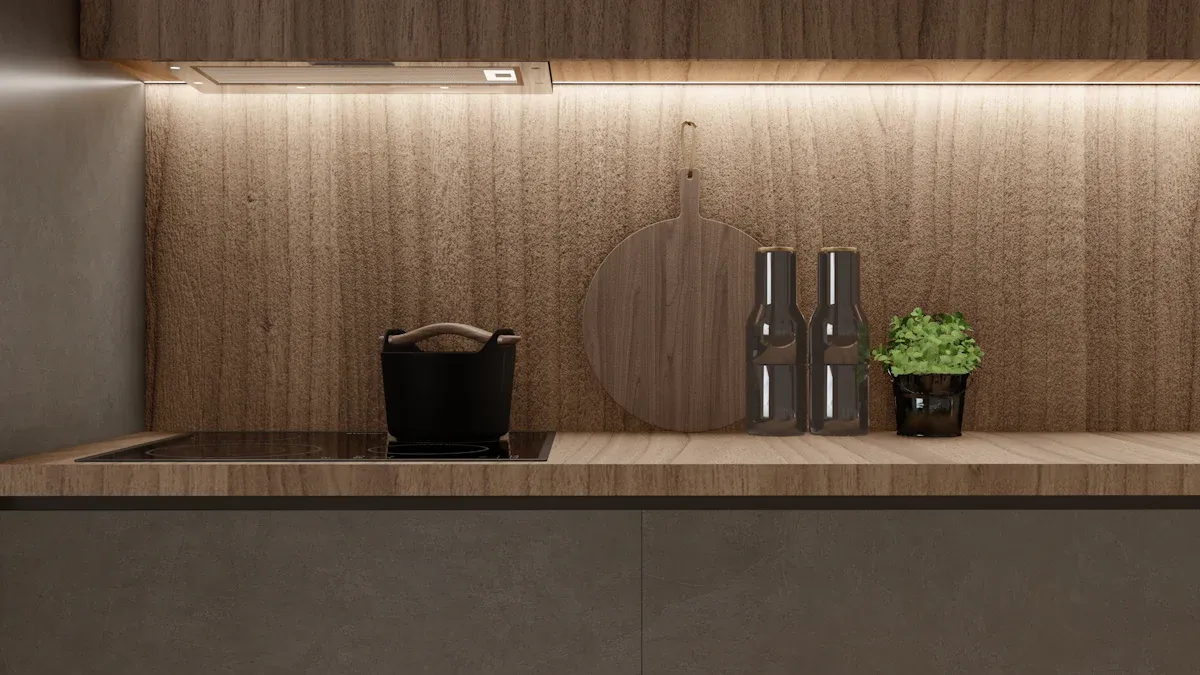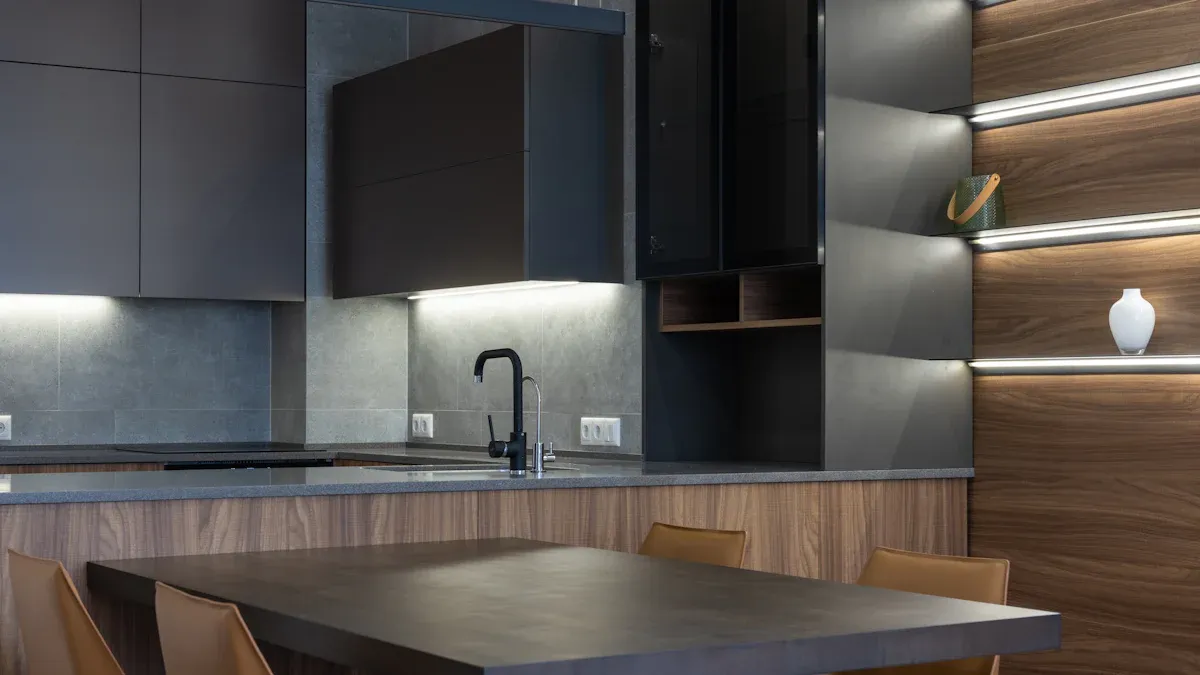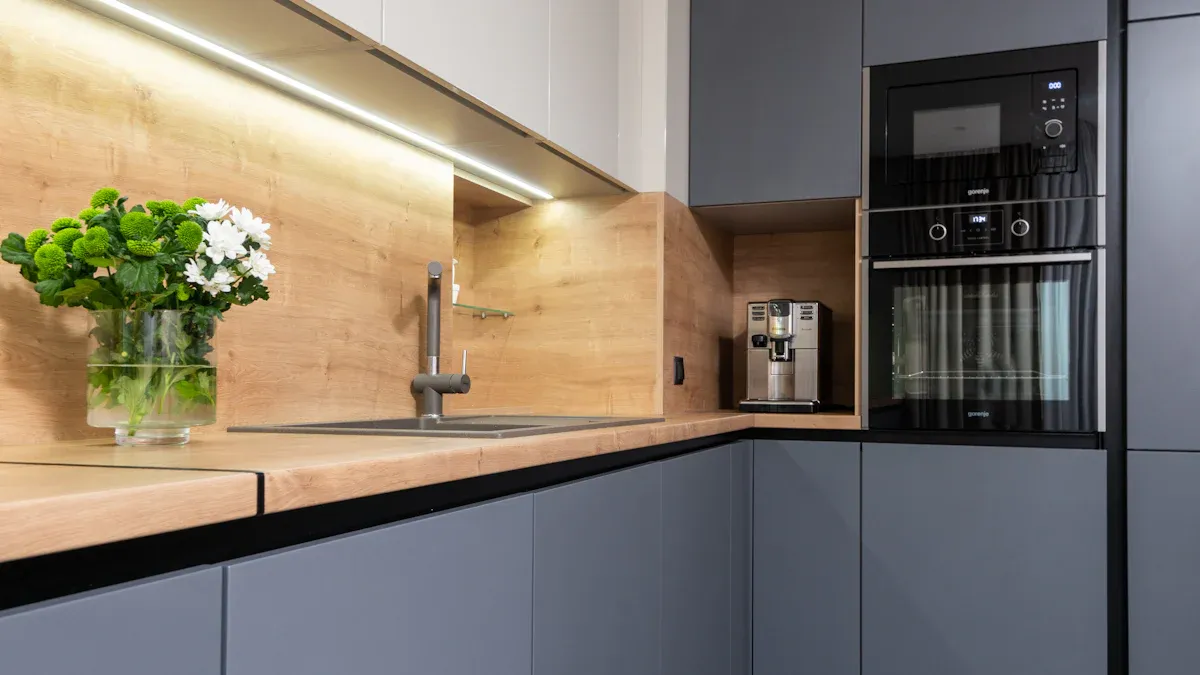
When I shop for under cabinet lighting, I always check a few must-haves:
- Lighting type and brightness
- Installation method
- Energy efficiency
- Smart features
- Safety and quality
- Upfront and long-term cost
Demand for smarter, energy-saving lights keeps growing, so I make sure each choice fits my space and daily routine.
Key Takeaways
- Choose LED under cabinet lighting for the best energy savings, long life, and safety.
- Pick the right brightness and color temperature to match your kitchen tasks and mood.
- Select an installation type—hardwired, plug-in, or battery—that fits your space and skill level.
Choosing Under Cabinet Lighting

Light Type
When I first started looking for under cabinet lighting, I felt overwhelmed by all the choices. The three main types I see most often are LED, compact fluorescent (CFL), and halogen. Each one has its own strengths and weaknesses. To make things clearer, I put together this table:
| Light Type | Power Consumption (vs. Incandescent) | Luminous Output/Efficacy | Lifetime (hours) | Notes |
|---|---|---|---|---|
| LED | 10% | High efficacy; same light with much less power | Up to 50,000 | Costs more at first, but saves money over time; very reliable |
| Compact Fluorescent (CFL) | 20% | About 800 lumens at 15 W (vs 700 lumens at 60 W) | N/A | Contains mercury, needs careful disposal; takes time to warm up; less common now |
| Halogen | 70% | More efficient than old bulbs, but still uses more power | N/A | Gets hot; not as energy efficient; shorter lifespan |
I always choose LED for my kitchen. LEDs use the least energy, last the longest, and give off very little heat. CFLs used to be popular, but I avoid them because they contain mercury and take a while to reach full brightness. Halogen lights look nice and are a bit brighter, but they get hot and burn out faster.
Tip: If you want to save money and avoid hassle, go with LED under cabinet lighting. It’s the best mix of efficiency, safety, and long-term value.
Color Temperature
Color temperature changes the mood of your kitchen. I like to think of it as the “feel” of the light. Warm white (2700K-3000K) gives a cozy, yellowish glow. Neutral white (3500K-4000K) feels clean and bright, perfect for cooking and prep work. Cool white (5000K+) looks crisp and modern, but sometimes feels harsh.
When I installed under cabinet lighting in my own kitchen, I picked neutral white. It made my counters look brighter without making the space feel cold. If you want a softer look, go for warm white. For a modern, high-energy vibe, try cool white.
Brightness
Brightness matters a lot, especially if you chop veggies or read recipes under your cabinets. I always check the lumens rating. For most kitchens, I aim for 200-500 lumens per foot of counter space. If you have dark countertops or want extra task lighting, go higher.
Here’s a quick way I figure out what I need:
- Small prep area: 200-300 lumens per foot
- Main cooking zone: 300-500 lumens per foot
I avoid lights that only list watts, since that doesn’t tell me how much light I’ll actually get. Lumens are the real measure.
Fixture Size
I measure my cabinets before I buy anything. Under cabinet lighting comes in bars, pucks, and strips. Bars and strips work best for long, even lighting. Puck lights create pools of light, which can look nice for accenting certain spots.
If my cabinets are deep or have odd shapes, I use flexible LED strips. For standard cabinets, I pick bars that match the length of the cabinet. I always leave a little space at the ends so the fixture doesn’t stick out.
Design and Fit
I want my under cabinet lighting to blend in, not stand out. I look for slim, low-profile fixtures that match my cabinet color. Some lights have a white or brushed nickel finish, which works with most kitchens. If I have glass-front cabinets, I pick a fixture that hides easily behind the frame.
I also check how the fixture mounts. Some snap in with clips, while others need screws. I pick the one that feels sturdy and doesn’t show wires. If I ever want to upgrade, I make sure the design lets me swap out the fixture without leaving holes or marks.
Note: Good design isn’t just about looks. A well-fitted light makes cleaning easier and keeps your kitchen looking sharp.
Installation, Features, and Safety

Hardwired, Plug-in, Battery
When I pick under cabinet lighting, I always start by thinking about how I want to install it. There are three main options: hardwired, plug-in, and battery-powered. Each one has its own perks and drawbacks.
- Hardwired lights connect directly to your home’s electrical system. They look neat because there are no visible cords. I usually call a professional for this type since it needs special wiring and must follow safety codes. Here’s a quick look at the specs:
Specification Details Amperage 20 A Voltage 125 V Wattage 2400 W Installation Needs a pro and specific instructions - Plug-in lights are much easier. I just plug them into a nearby outlet. They work great for renters or anyone who wants a quick upgrade without hiring an electrician. The only downside is the visible cord, but I can usually hide it behind the cabinets.
- Battery-powered lights are the easiest to install. I don’t need any wiring or outlets. I just stick them where I want. These lights use batteries like alkaline or lithium-ion. I love using them in spots where I can’t run wires. Some even have motion sensors or remote controls. The only catch is I have to replace or recharge the batteries, and they can get dimmer over time.
Tip: If you want a fast, no-fuss solution, try battery-powered or plug-in lights. For a seamless, permanent look, go with hardwired.
Voltage and Wattage
I always check the voltage and wattage before I buy any light. Hardwired under cabinet lighting usually runs on 120-125 volts, just like most home outlets. The wattage tells me how much power the light uses. I try to pick lights that give me enough brightness without wasting energy. Plug-in and battery lights often use less power, which is great for saving on my electric bill.
If I’m not sure about the wiring or power needs, I ask an electrician. Safety comes first, especially with anything electrical.
IP Rating
Kitchens can get messy. Water, steam, and grease are everywhere. That’s why I look for an IP (Ingress Protection) rating on my under cabinet lighting. The IP rating tells me how well the fixture keeps out dust and moisture. For kitchens, I aim for at least IP20. If the lights are near a sink or stove, I go higher, like IP44, for extra protection.
Note: A good IP rating means my lights last longer and stay safe, even in a busy kitchen.
Dimmable and Motion Sensor
I love having control over my lighting. Dimmable under cabinet lighting lets me set the mood for late-night snacks or bright task work. Some lights come with built-in dimmer switches, while others work with wall dimmers. I always check compatibility before I buy.
Motion sensors are another cool feature. I use them in spots where my hands are full or I just want the lights to turn on automatically. Battery-powered motion sensor lights are perfect for pantries or dark corners.
Linkable and Smart Options
Sometimes, one light isn’t enough. That’s when I look for linkable lights. These let me connect several fixtures together, so I get even lighting across my whole counter. I just plug them into each other or use a connector cable.
Smart under cabinet lighting is getting more popular. I can control these lights with my phone, voice assistant, or even set schedules. It’s a fun way to add convenience and save energy.
Energy Efficiency
Energy efficiency is a big deal for me. I want bright lights that don’t run up my electric bill. LED under cabinet lighting is my top pick. LEDs use up to 90% less energy than old incandescent bulbs and last 25 times longer. That means I save money and don’t have to change bulbs as often.
- LED strip lights give me at least 200 lumens per foot, which is plenty for most kitchens.
- Energy-efficient lighting can cut my home’s electricity use by about 15%. That’s around $225 in savings every year.
- Choosing dimmable lights and the right color temperature (2700K-3000K) helps me save even more.
Did you know? Lighting makes up about 13% of global energy use and 5% of carbon emissions. Picking efficient lights helps the planet, too.
Compliance and Certification
I always check for safety certifications before I buy any under cabinet lighting. Products with UL (Underwriters Laboratories) certification have passed strict safety tests. I also look for IEC, ISO, EN, or CIE marks. These show the lights meet international standards for quality and safety.
- UL certification means the product is safe and reliable for home use.
- IEC and ISO standards cover electrical safety and product quality.
- Some products even qualify for rebates because they meet energy and safety regulations.
Safety First: Certified lights give me peace of mind. I know they’re built to last and won’t cause problems down the road.
Cost and Value
I always weigh the upfront cost against long-term value. LED under cabinet lighting might cost more at first, but it saves me money over time with lower energy bills and fewer replacements. I check the warranty, too. A good warranty means the company stands behind its product.
Here’s what I consider:
- Initial price
- Expected lifespan
- Energy savings
- Warranty coverage
Sometimes, spending a little more upfront means I get better quality and fewer headaches later.
When I choose under cabinet lighting, I always check brightness, type, features, and safety. I measure my space and think about what I need now and later. If you use this checklist, you can pick the best lights for your kitchen and feel confident about your choice.
FAQ
How do I hide wires for under cabinet lighting?
I usually tuck wires behind the cabinet or use adhesive cable clips. Some kits come with covers that match my cabinet color.
Can I install under cabinet lights myself?
I can install plug-in or battery lights on my own. For hardwired lights, I always call a licensed electrician for safety.
What if my cabinets are different sizes?
I mix and match light bars or strips. I measure each cabinet and pick the right length for a custom fit.
Post time: Jul-04-2025






